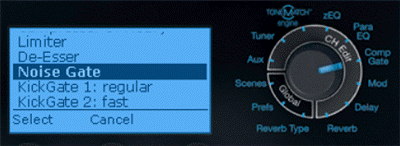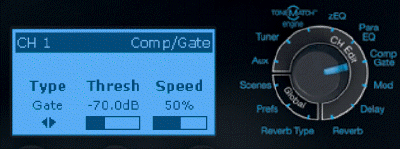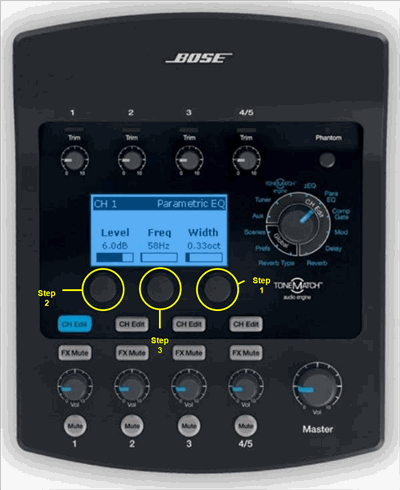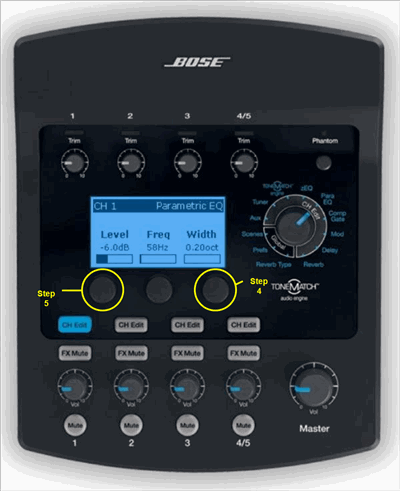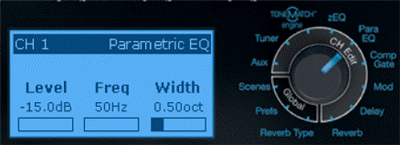T1 ToneMatch® Audio Engine / Tips & Tricks
Tricks for Solving Problems
Feedback
Feedback: Para EQ
Feedback/T1 ToneMatch™ Audio Engine
Feedback: Comp Gate / Noise Gate
Use the CompGate - Noise Gate to effectively mute the microphone when there is not a strong vocal.
You will have to experiment to find the best setting.
- Thanks Musicman,
It seems so obvious now that the Noise Gate is the answer; still, your post prompted my epiphany. We play electric and definitely louder that an acoustic act. (ex: I use either two customized Blues Jr's in stereo, my '65 Super Reverb, or my ProTube Twin Amp on stage) The tonematch's Noise Gate solved the feedback resulting form my need to push the vocal mike to the max. Also, I don't have to stand in between the microphone and the Bose to avoid that ensuing ring. The band was awestruck by my the improvement in my "mixing prowess". Of course, I didn't tell them that you cued me in. Thanks, (and don't tell anyone you told me, ha!)
Feedback Problems - Esparka
Isolating a Problem Frequency
Introduction
You can use the Parametric EQ feature to notch out a problem frequency. Here are a few real-world examples.
This article applies to all ToneMatch mixers (T1/T4S/T8S).
Bassist With Excessive Resonance at B flat
Chuck-at-Bose provided this approach.[1]
|
|
|
4. Adjust the Width control to as narrow a value as possible, so that only the problem is being affected, leaving the non-offending frequencies around it unchanged. The T1 goes down to one fifth (0.20) of an octave, which is great for 'notching out' problem notes. |
Another Approach to Eliminating a Boomy Note
Hilmar-at-Bose had a different approach[2]
a) set the level of the para EQ to a cut, say -10 dB
b) set the width to fairly narrow, say .25 octaves
c) start with a rough estimate of the offending frequency and then move the frequency around until the offending note gets tamed best
d) you can press on the level control to toggle between on and off which gives you a direct A/B so you can judge the effect better
Once you have centered on the frequency you adjust the level and width to taste.
Estimating the frequency:
- Low octave of the bass is from 40 Hz to 80 Hz (E1 to E2), A1 is at 55 Hz
- Low octave on the guitar is from 80 Hz to 160 Hz (E2 to E3), A2 is at 110 Hz
- 2nd octave on the guitar is from 160 Hz to 320 Hz (E3 to E4), A3 is at 220 Hz
Here is a cheat sheet: Frequency vs. Musical Notes Graphic from MIT
Piezo Pickup Thump
If you have an Acoustic Guitar that is picking up low end thump from a percussive right hand technique use the Para EQ with settings like this.
- Level -15
- Frequency 50 Hz
- Width 0.50
T1 and x bridge - Strat man
Single Coil Buzz
Use the Noise Gate
The default settings seem to work okay for me.
eliminating single coil buzz - jayare and ST
Wind Noise
- A microphone responds to the movement of air and it does not care what caused the air to move. This means that a mic cannot distinguish between air movement originating from a talker, and air movement originating from local weather. Wind noise is a persistent problem with microphones but there are multiple ways to minimize unwanted noise.
- Wind noise has a large amount of low frequency (bass) content, often described as “rumble.” Cutting out the extreme bass from a microphone signal is an effective method to reduce audible wind noise.
Source: shure tech tips to minimize wind noise
Use the ParaEQ (Woody B called it the notch filter)
- I had an extremely windy gig last night. Even with windscreens on the mics they still had the wind rumble. I used the notch filter on my T1 to notch the wind sound out. I don't believe it's called a notch filter on the T1, but I don't remember the correct name. I just turned the volume way up, and adjusted the frequency until the wind noise was gone. I tried using the noise gate, but if it was high enough to eliminate the wind it also eliminated most of the vocals. Usually wind screens solve any wind problems I have, but the wind was so strong I kept my guitar case on stage to sit my guitar in, instead of using a stand. I believe the wind would have blown it over.
What to do in windy conditions - Woody B
Piezo Pickup Thump
Use the ParaEQ
T1 and x bridge - Strat man
Single Coil Buzz
Use the Noise Gate
The default settings seem to work okay for me.
eliminating single coil buzz - jayare and ST
Wind Noise
Use the ParaEQ (Woody B called it the notch filter)
- I had an extremely windy gig last night. Even with windscreens on the mics they still had the wind rumble. I used the notch filter on my T1 to notch the wind sound out. I don't believe it's called a notch filter on the T1, but I don't remember the correct name. I just turned the volume way up, and adjusted the frequency until the wind noise was gone. I tried using the noise gate, but if it was high enough to eliminate the wind it also eliminated most of the vocals. Usually wind screens solve any wind problems I have, but the wind was so strong I kept my guitar case on stage to sit my guitar in, instead of using a stand. I believe the wind would have blown it over.
What to do in windy conditions - Woody B
Tips
A/B Comparisons using Bypass
T1 ToneMatch™ Audio Engine/Bypass
Passive Piezo Pickups
If you have instruments with passive pickups, and instruments with active pickups or preamps, try the passive pickups in T1™ Channels 1, 2, or 3. You can put the instruments with active pickups or preamps into Channels 4/5. Bouzouki with passive McIntyre Pickup to T1™ - MBanshee.
Switching between Instruments
Mary (Banshee in the Kitchen) noted [1] T1 ToneMatch™ Audio Engine / Switching Between Instruments
Use the T1 ToneMatch Audio Engine with a non-Bose PA
- If your mystery system is voiced to a normal-sounding spectral distribution (like the L1's), the presets in the T1 will work fine. If not (a really good probability, especially if it's an odd-brand "installed" system), all bets are off. Actually, even if it's a really good installed system but all the controls (like the house EQ) are readily accessible, chances are this will fall into the "not" category too. In either case, the loop is wide open at this point. Might as well leave the T1 in the car.
- -- Cliff-at-Bose [2]
- What Cliff is getting at is the fact that the house system may be 'voiced' any number of ways. In almost all cases a house system will be voiced quite differently from an L1, which will make the presets sound much differently than intended.
- We just don't know what will happen. The presets may work great, they may not work well. No way to tell until sound check.
- Bring the T1 though - worst case scenario is you leave your EQ's flat.
- -- MikeZ-at-Bose [3]
- ↑ Mary (MBanshee) in the Bose Community Message Boards
- ↑ Cliff-at-Bose Value of Presets
- ↑ MikeZ-at-BoseValue of Presets
